How to use Word's Step By Step Mail Merge Wizard to create labels.
If you are printing your own labels using Microsoft Word and you need to add different information to each label then you definitely need to know about Mail Merges.
Watch a video: this advice is also available in video format.
View our step by step How To video to learn how to use mail merge to make labels.
A mail merge basically takes a single document (e.g. a letter or a label template) and a data source (e.g. a spreadsheet of addresses or a database of product information) and merges the two together to create multiple documents (or labels) that share the same basic design but are uniquely personalised with the information from each of the records within the data source. In other words, for example, you end up with 50 letters that are personalised with each recipient’s name and address OR you end up with a set of 100 labels that share the same basic design but are personalised with a different product number.
There are a few different ways to complete a mail merge but this post will focus on the Mail Merge tool that is built into Word – and specifically how to use the “Step By Step Mail Merge Wizard” to design a set of labels that share a common design but are allocated unique information from a data source.
To begin the Mail Merge Wizard, you simply open Word, create a blank starting document, click on the “Mailings” tab at the top of the page, and then click on “Start Mail Merge” and select “Step By Step Mail Merge Wizard” from the drop down menu.
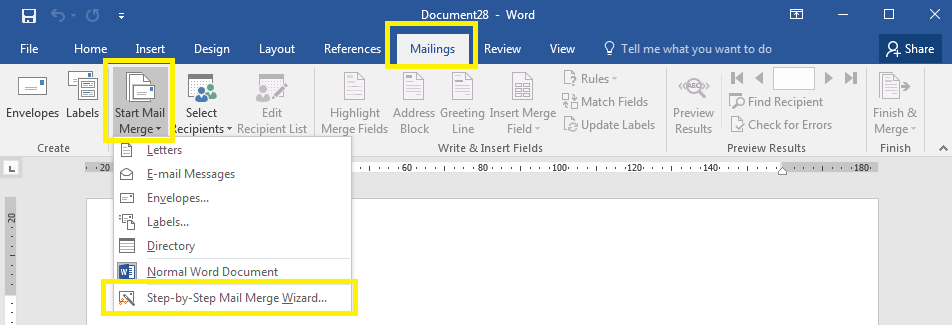
The Wizard then guides you through the SIX steps involved in completing a mail merge, which go something like this:
Step 1: Select document type
As the mail merge tool can be used to create a variety of documents, first you need to let Word know what sort of document you are creating: to do this, simply click on “Labels” in the Mail Merge Wizard panel on the right hand side.
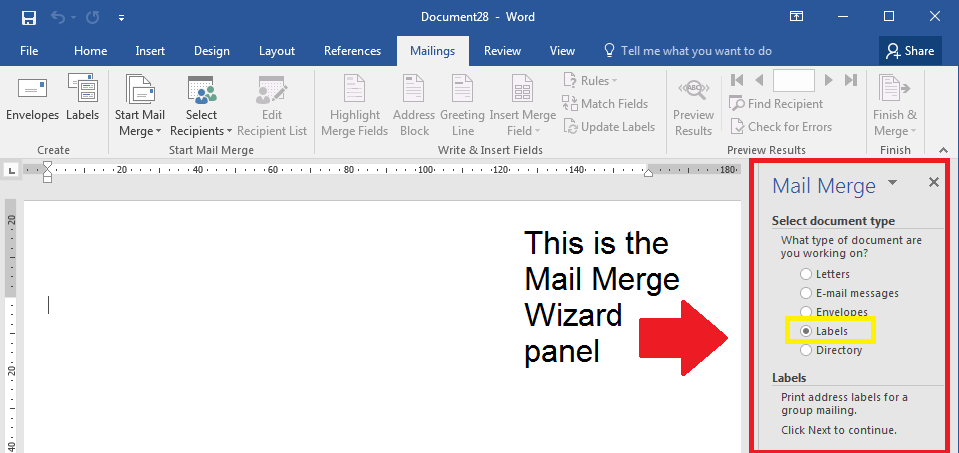
Step 2: Select starting document
You now have the choice of using a template that you have downloaded from somewhere else (using the “Start from existing document” option) or using a compatible built-in template or making your own template (using “Change document layout” and “Label options”).
Bear in mind that the Mail Merge tool works more efficiently with a built-in template because Word is updating a template that is basically a part of itself (allowing the Mail Merge steps to be completed automatically) – if you use a standalone template, however, you will need to perform some of the steps yourself.
Step 3: Select recipients
Next you select the data source that you want to use for your mail merge; you can create your list at this point but it’s generally easier (and quicker) if you’ve already got your data source set up and saved somewhere before starting your mail merge. Click on “Browse” to navigate to the folder where your data source is saved.
First you will be shown a pop up box titled “Select Table”, which allows you to do TWO key things:
- If your data source contains multiple tables (or sheets, if you are using a spreadsheet), then you need to indicate which table or sheet holds the information that you want to add to your labels.
- You can also let Word know if your data source has column headers for your data (for example, if the top row in your spreadsheet indicates the contents of each column – e.g. “Name”, “Address Line 1”, “Product Code”, “Price” etc).
Next, you will be shown another pop up box titled “Mail Merge Recipients”; this shows you a list of the records that will be used to populate your labels – you can sort and filter your data at this point to exclude any records that you don’t want to use.
Once you have confirmed that you are happy with your list (by clicking “OK”), the wizard will then automatically add the rule “Next Record” to each label in your template (apart from the first, top left, label) – as shown below.
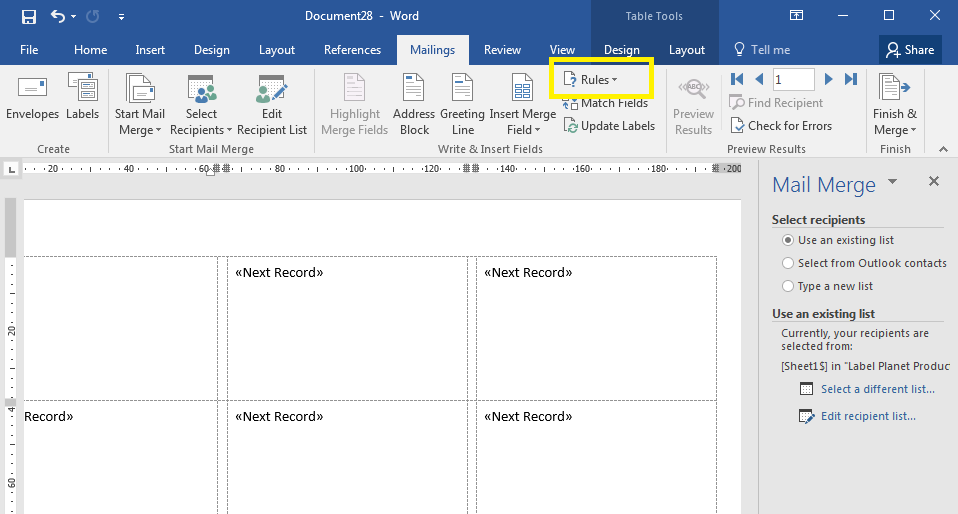
STANDALONE TEMPLATE: if you are using a standalone template, you will need to add the “Next Record” rule yourself. You left click once inside the second label in your template and then click on the “Rules” button in the “Mailings” tab at the top of the page and select “Next Record” from the drop down menu. You can then repeat this for the remaining labels OR you can copy the rule you have already added and paste it into the rest of the labels.
Step 4: Arrange your labels
This is the stage where you add your label design; as always, the best way to do this is to add your design to the top left label before copying this into the rest of your labels – the Mail Merge even provides a useful button (“Update all labels”) that does this for you automatically.
When you want to add a piece of information from your data source, you need to add a placeholder to your design – this takes the form of the column header you provided in your data source enclosed by two outward facing arrow heads (known as “guillemets” or “double angle quotation marks”) – like this: «column_header». You can either use preformatted options (e.g. the “Address block” and “Greeting line” options shown in the Mail Merge Wizard panel) or you can manually add a piece of information by clicking on the “More items” option.
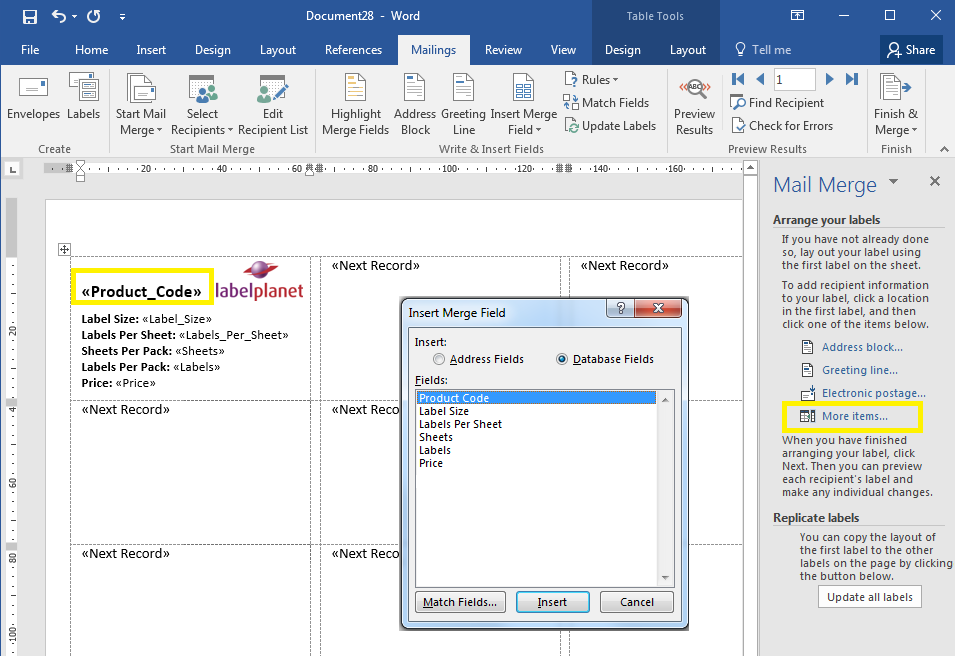
In our example, we have added a company logo to the top right corner of the label, added a placeholder in a large bold font for the product code, and added text and placeholders for the rest of the information that is to be added to our labels (Label Size, Labels Per Sheet, Sheets Per Pack, Labels Per Pack, and Price). The text that does NOT have guillemets will remain as part of the design, while the placeholders enclosed by the guillemets will be replaced by the information from the data source that they represent.
REMEMBER: the information that replaces your placeholders may take up MORE space or LESS space once you complete the merge. You can check this in the next step (Preview your labels) and you can go back and forth as many times as you need to make sure your design and your information merge together in a way that fits neatly onto each label.
If you do need to make any changes, remember you only need to make them to the top left label before using the “Update all labels” to add your updates to the rest of the labels.
STANDALONE TEMPLATE: if you are using a standalone template, the “Update all labels” button is not available and you will need to add your design to the rest of your labels using the usual “copy and paste” method.
Please note that you MUST ensure that the “Next Record” rule sits at the start of each label, otherwise your labels will not be updated with the correct set of information from your data source.
Step 5: Preview your labels
At this point, the wizard will create a mock-up of what your finished label template will look like – so you can check for any errors or problems in your design (and correct them) before you complete your merge.
We recommend scrolling through a few of your “recipients” (i.e. the records in your data source) to make sure that your information fits neatly into your label design – ideally, if you know that a particular record contains information that is longer than the other records you should make a point of checking how that record fits into your label design (you can use the “Find a recipient” option in the wizard panel to do this).
For example, some people who use the Mail Merge tool to print address labels will assume that they can go ahead and print their labels because the preview of the first few addresses in their data source looks fine – unfortunately, when they go on to print the full set of labels, they discover that some records have more address lines and this pushes their design (and their addresses) off the edge(s) of their labels.
If you do find that you have one or two records that contain information that doesn’t quite fit into your design, remember you have the option of going back to the previous step and changing your label design slightly OR you can use the “Edit recipient list” in the Mail Merge Wizard panel to edit the information for those records (if you can) so you don’t have to change your whole design for the sake of a few records.
Step 6: Complete the merge
Finally, you can complete the merge and print your finished labels.
BUT DON’T JUST YET!
As always, here at Label Planet, we recommend using a little caution and doing a test print before you print your full set of labels onto your label sheets. Click on “Print”, select the bottom option, and enter “1” into the “From” field and enter the number of labels per sheet in the “To” field (in our example, we’re printing LP21/63, which has 21 labels per sheet – so we would enter 1 in the “From” field and 21 in the “To” field). This will print one sheet only and will allow you to double check that your template will print onto your labels with the correct alignment before you print your full set of labels.
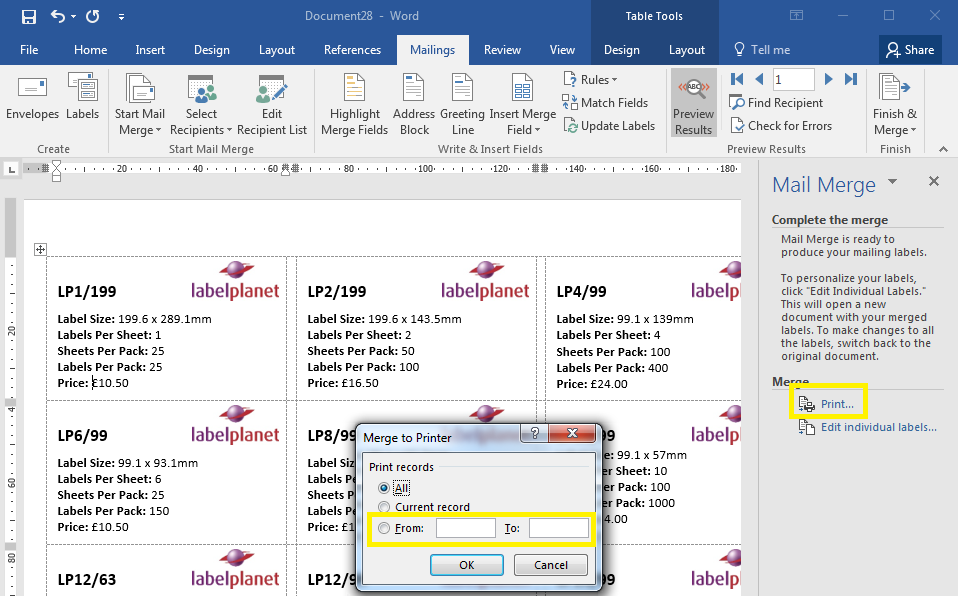
Remember, after you select the records you want to print, you will be directed to the Printer Properties box; you should take a moment to go through the settings to make sure your printer is correctly set up for printing onto A4 label sheets as follows:
- Select a specific “Labels” or “Heavy Paper” print option
- Make sure the page size is set to A4
- Make sure your printer is set up to print to the media bypass tray
- Make sure no scaling options are selected (e.g. “Fit to page” / “Fit to sheet” / any percentage less than 100%)
- Make sure no options such as “Ignore Printer Settings” or “Use Default/Driver Settings” are selected
Once you are happy with your test print you can load your labels into your printer (making sure that you use the media bypass tray if your printer has one) and print your full set of labels.
USING A SAVED MAIL MERGE
- Remember that your label template and data source are LINKED. You need to keep both files safe to reuse the mail merged template.
- If you update your data source, your changes will be available in your label template the next time you open your template.
- If you lose, rename, or move your data source, you can reconnect your label template (or link it to a new data source) by clicking on Mailings and choosing "Select Recipients".
- To print from a saved mail merge, you will need to click on the Mailings tab and select Finish & Merge. This will bring up all of the print options from Step Six. If you try to use the normal way of printing (by selecting File and Print), you will only be able to print the one page of labels visible on your screen.
 Label Planet
Label Planet